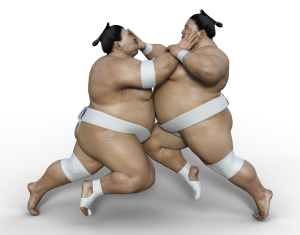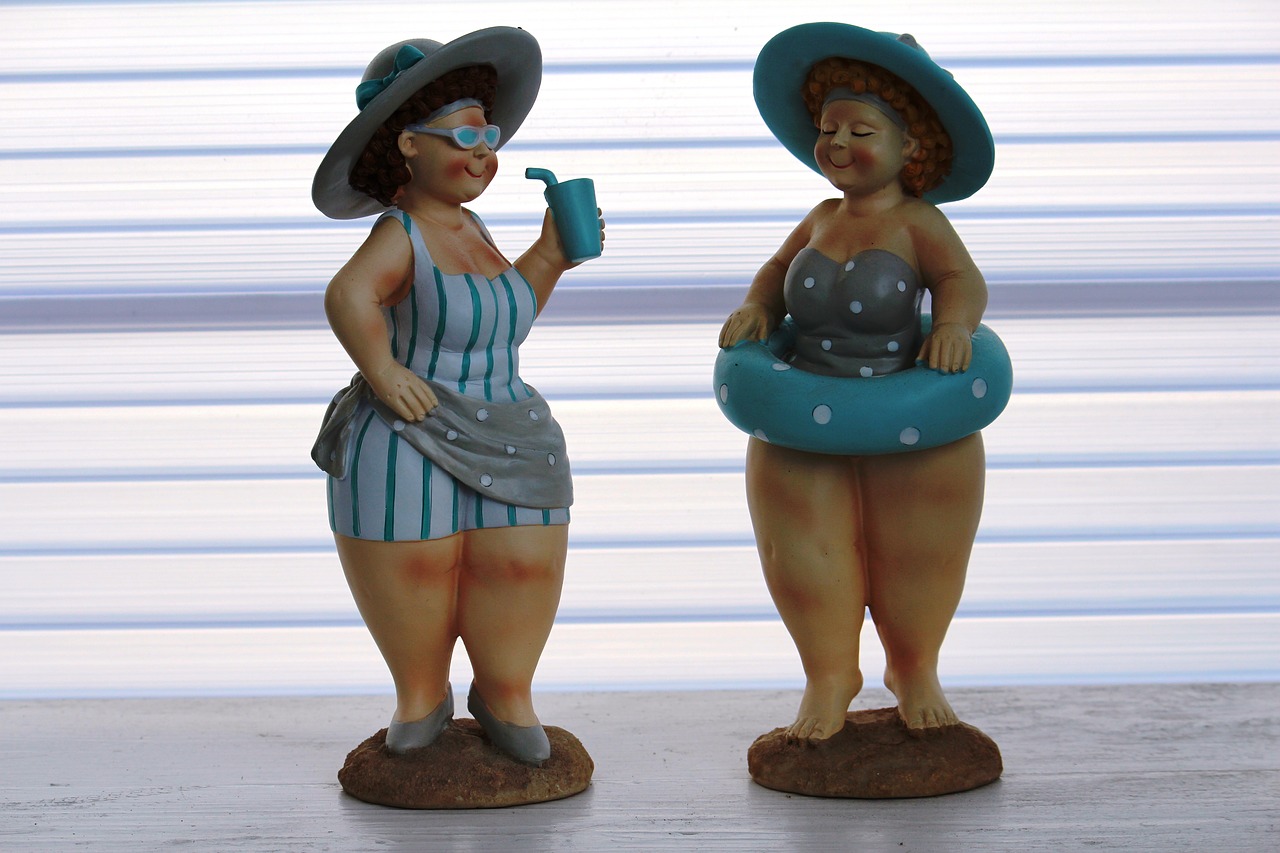Was man schön findet, ist nicht immer privat. Sobald man es hinausposaunt, wird es auch gesellschaftlich. Daher fordert eine neue Bewegung, das vermeintlich Unschöne schön zu finden: Body Positivity.
Wäre das nicht was für uns in den besten Jahren? Wenn wir schon Falten und Fett ansammeln, dann bitte mit Applaus! Allerdings hat die Sache zwei Haken.

Haken Nummer eins:
Mit dem vehementen Toleranz-Diktat könnten Stereotype erst recht zementiert werden. Wenn ich fordere, dass ältere Körper als schön empfunden werden, untermauere ich die Annahme, dass sie es nicht sind.
Die verordnete Körperakzeptanz ist eine feministisch basierte Idee. Nur die diskriminierte Weiblichkeit wehrt sich gegen das Schönheitsdiktat. Weil es Männer in der Regel nicht anficht.
Zwei Beispiele, wie der Common Sense wohl noch tickt:
- Sagt er zu ihr: „Ich find‘ dich toll, obwohl du Falten hast.“ (Boah, wow, unglaublich!)
- Sagt sie zum ihm: „Ich find‘ dich toll, obwohl du Falten hast.“ (Na, was denn sonst?)
Oder:
- Sagt er zu ihr: „Ich finde deinen Bauch ja süß.“ (Oh, wie großmütig!)
- Sagt sie zu ihm: „Ich finde deinen Bauch ja süß.“ (Ganz schön frech, die Dame.)
Doch sollte man sich auch hier vor Klischees hüten. Schließlich lastet der Schönheitsdruck immer häufiger auch auf Männerschultern. Man kann wohl davon ausgehen, dass so mancher aus der männlichen Spezies, der eitle Selbstgefälligkeit nachgesagt wird, sehr wohl Schönheitsnormen erfüllen möchte. Und sich schlecht fühlt, weil er es nicht kann.
So heißt es für beide Geschlechter: Wohl denen, die genügend Selbstliebe besitzen, um vermeintliche Makel selber zu akzeptieren. Es kommt auf den Grad der Selbstverständlichkeit an, mit der man Falten und Pfunde trägt. Wer Selbstakzeptanz in den Wald hineinruft, dem schallt Toleranz entgegen. Und auch das ist kein Geheimnis: Je mehr jemand sich akzeptiert und akzeptiert wird, desto weniger ist das Aussehen ein Gesprächsthema.
Aber wie viele Menschen haben schon diese sympathische selbstverständliche Strahlkraft, die jede Äußerlichkeit überblendet?
Also empfehlen die Body Positivisten, sich vor dem Spiegel täglich schön und liebenswert zu reden. Die Frage ist nur: Ist kämpferische Selbstsuggestion („Ich bin schön, wie ich bin“) ein Mittel, gesellschaftliche Schönheitsmuster zu verändern? Oder wird sie nicht auch Unsicherheit ausdrücken: „Akzeptiert mich gefälligst so (unattraktiv), wie ich bin!“

Und seien wir ehrlich: Schönheit beim Älterwerden ist doch wieder ein Thema der Frau. Das gilt auch für die Art, wie sie mit dem äußerlichen Älterwerden umgeht. Die einen halten es für völlig unangemessen, wenn frau sich noch kräftig schminkt und modisch stylt. (Dezent, bitte, dezent!) Die anderen halten das allmähliche Verschwinden im Rentnerbeige-Nebel für inakzeptabel und deprimierend. Konsens gibt es wohl nur im Extrem: Bei Vernachlässigung des Äußeren schauen alle lieber weg.
Mit den Schönheitsidealen ist es jedenfalls so eine relative Sache: Bei manchem späteren Topmodel musste erst entdeckt werden, dass der Leberfleck und die Zahnlücke kein Deal-Breaker sind, sondern im Gegenteil das Quäntchen Individualität, das das Antlitz noch schöner macht.
Und heute tut sich doch was in den normengebenden Instanzen: Unserem auf jugendliche Schlankheit geeichten Schönheitsempfinden zum Trotz gibt es in Werbung und Medien seit längerem auch ältere Models und kurvige.
Allerdings keine fettleibigen.
Wir finden Übergewicht inzwischen zwar als normal, aber noch lange nicht schön. Wichtigster Body-Positivity-Streitpunkt ist und bleibt die unbegrenzte Körperfülle. Ich bin rund, na und?
Kommen wir zum Haken Nummer zwei:
Etwas wird in der gesamten Diskussion scheinbar völlig übersehen. Das Übermaß an Körperfett ist nur zum Teil eine Frage der Ästhetik. Ein erhebliches Problem liegt in den Gesundheitsrisiken, die mit den Jahren immer größer werden.
Darüber können auch euphemistische Namen wie Adipositivity nicht hinwegtäuschen. Unter der Wortkreation aus Adipositas und Positiv will ein amerikanisches aktivistisches Fotoprojekt in der Gesellschaft „fat acceptance“, also Fettakzeptanz erreichen.
In anderen Teilen der Welt wäre das gar nicht nötig. Body Positivity der besonderen Art herrscht in großen Teilen des afrikanischen Kontinents. Äußerst füllige Frauen mit breiten Hüften und großen Hintern gelten als richtig hot. Nichts leichter – zumindest in Gebieten mit wachsender Mittelschicht –, als sich diese Idealfigur mit Fastfood und Softdrinks anzufuttern. Die Folge ist ein drastischer Anstieg der gleichen ernährungsbedingten Krankheiten wie in den Industrienationen.

Das heißt, auch die Teilnehmer(innen) von Adipositivity bedürfen möglicherweise bald nicht mehr der Bewunderung, sondern der Behandlung, zum Beispiel von Stoffwechselstörung, Fettleber und Diabetes Typ 2. Dann werden Arzt oder Ärztin der Fettakzeptanz mit der ausgesprochen intoleranten Forderung begegnen: „Und jetzt nehmen wir mal ordentlich ab“. Und es wird klar, wie negativ sich die Positivity auswirken kann. Oft befinden sich auf der großen Hautoberfläche metallhaltige Tattoos als weitere Fanale der körperlichen Selbstbestimmung. Das kann diagnostische Verfahren mittels Magnetresonanztherapie ausschließen – ein weiteres Thema.
Das eine Schön und das andere Schön
Was könnte Body Positivity nun fürs Älterwerden bedeuten? Wollen wir Akzeptanz oder Disziplin? Wie wäre es mit beidem?
Das eine Schön ist das, was von der Gesellschaft so empfunden wird. Denn die Schönheit der reifen Persönlichkeit ist zweifelsohne da, nur der Sinn dafür könnte sich gerne schneller und auf breiterer Ebene entwickeln als auf vereinzelten Pinterest-Blogs.
Das andere Schön ist, was auch vom eigenen Organismus so empfunden wird. So gesehen kommt Schönheit eben doch von innen.

English Version
Body Positivity – Beautiful ageing with applause?
What one finds beautiful is not always private. The moment you let it out, it becomes social. Therefore, a new movement demands to find the supposedly unattractive beautiful: Body Positivity.
Wouldn’t that be something for us in our prime? If we’re going to accumulate wrinkles and fat, let’s hear it. There’s just two things wrong with it.
Here is the catch number one:
With the vehement tolerance dictate, stereotypes could be cemented even more. When I demand that older bodies be perceived as beautiful, I support the assumption that they are not.
The prescribed body acceptance is a feminist based idea. Only discriminated femininity defends itself against the dictates of beauty. Because it doesn’t usually challenge men.
Two examples of how Common Sense still ticks:
- He says to her, „I love you even though you have wrinkles.“ Whoa, wow, unbelievable!
- She says to him, „I love you even though you have wrinkles.“ Well, what else?
Or
- He says to her, „I think your belly is cute.“ Oh, how magnanimous.
- She says to him: „I think your belly is sweet.“ You’re very naughty, lady.
But one should beware of clichés here too. After all, the pressure of beauty is increasingly weighing on men’s shoulders. It is safe to assume that some of the male species, who are said to be vainly complacent, do indeed want to meet beauty standards. And feels bad because he can’t.
Thus it is said for both sexes: Happy are those who have enough self-love to accept supposed flaws themselves. It depends on the degree of matter-of-factness with which one wears wrinkles and pounds. Whoever calls self-acceptance into the forest echoes tolerance. And that’s no secret either: the more someone accepts themselves and is accepted, the less appearance is a topic of conversation.
But how many people have this sympathetic, natural charisma that fades out every outward appearance?
So the Body Positivists recommend that you talk yourself beautifully and lovingly in front of the mirror every day. The only question is: Is combative self-suggestion („I am beautiful as I am“) a means to change social patterns of beauty? Or will it not also express uncertainty: „Accept me as (unattractive) as I am!
And let’s be honest: beauty as we grow older is again a woman’s issue. This also applies to the way she deals with aging. Some people think it is completely inappropriate for women to wear heavy make-up and fashionable styling. Others find the gradual disappearance in the pensioner beige fog unacceptable and depressing. There is probably only consensus in the extreme: if the appearance is neglected, everyone prefers to look away.
With the beauty ideals it is at any rate a relative thing: With some top models it had to be discovered that the mole and the gap between the teeth are not a deal-breaker, but on the contrary, that little bit of individuality that makes the face even more beautiful.
And today something is happening among the standard-setting authorities: Despite our sense of beauty calibrated to youthful slimness, older models and curvaceous ones have been appearing in advertising and the media for some time now.
But not obese ones.
We now find overweight to be normal, but it is still far from beautiful. The most important body-positivity issue is and remains unlimited body volume. I am round, so what?
Let’s move on to catch number two:
Something seems to be completely overlooked in the whole discussion. The excess of body fat is only partly a question of aesthetics. A significant problem lies in the health risks, which increase with the years.
Even euphemistic names such as Adipositivity cannot hide this. An American activist photo project has created the combination of the words adiposity and positive in order to achieve „fat acceptance“ in society.
In other parts of the world this would not be necessary at all. Body positivity of a special kind prevails in large parts of the African continent. Extremely plump women with wide hips and big bottoms are considered really hot. Nothing easier – at least in areas with a growing middle class – than to feed this ideal figure with fast food and soft drinks. The result is a drastic increase in the same diet-related illnesses as in the industrialised nations.
This means that even the participants of Adipositivity may soon no longer need admiration, but rather treatment, for example of metabolic disorders, fatty liver and type 2 diabetes. Then doctors will meet fat acceptance with the extremely intolerant demand: „And now let’s lose weight properly“. And it becomes clear how negative the positive effects can be. Often there are metal-containing tattoos on the large surface of the skin as further fancies of physical self-determination. This can exclude diagnostic procedures using magnetic resonance therapy – another topic.
The one beautiful and the other beautiful
What could Body Positivity mean for aging? Do we want acceptance or discipline? How about both?
The one beautiful is what is felt by society. For the beauty of the mature personality is undoubtedly present, only the awareness of it could gladly develop faster and on a broader level than on isolated Pinterest blogs.
The other beautiful is what is also felt by one‘ s own organism. Seen in this way, beauty does come from within.




